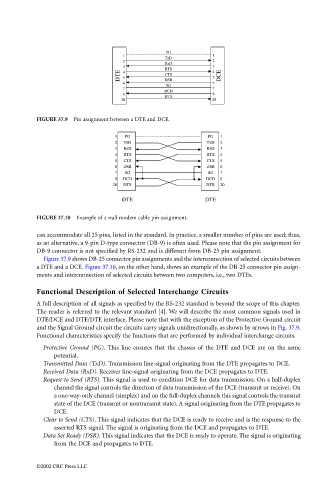Page 1061 - The Mechatronics Handbook
P. 1061
PG
1 1
TxD
2 2
RxD
3 RTS 3
DTE 4 DSR 4 5 DCE
CTS
5
6 6
SG
7 7
DCD
8 8
DTR
20 20
FIGURE 37.9 Pin assignment between a DTE and DCE.
1 PG PG 1
2 TxD TxD 2
3 RxD RxD 3
4 RTS RTS 4
5 CTS CTS 5
6 DSR DSR 6
7 SG SG 7
8 DCD DCD 8
20 DTR DTR 20
DTE DTE
FIGURE 37.10 Example of a null modem cable pin assignment.
can accommodate all 25 pins, listed in the standard. In practice, a smaller number of pins are used; thus,
as an alternative, a 9-pin D-type connector (DB-9) is often used. Please note that the pin assignment for
DB-9 connector is not specified by RS-232 and is different from DB-25 pin assignment.
Figure 37.9 shows DB-25 connector pin assignments and the interconnection of selected circuits between
a DTE and a DCE. Figure 37.10, on the other hand, shows an example of the DB-25 connector pin assign-
ments and interconnection of selected circuits between two computers, i.e., two DTEs.
Functional Description of Selected Interchange Circuits
A full description of all signals as specified by the RS-232 standard is beyond the scope of this chapter.
The reader is referred to the relevant standard [4]. We will describe the most common signals used in
DTE/DCE and DTE/DTE interface. Please note that with the exception of the Protective Ground circuit
and the Signal Ground circuit the circuits carry signals unidirectionally, as shown by arrows in Fig. 37.9.
Functional characteristics specify the functions that are performed by individual interchange circuits.
Protective Ground (PG). This line ensures that the chassis of the DTE and DCE are on the same
potential.
Transmitted Data (TxD). Transmission line-signal originating from the DTE propagates to DCE.
Received Data (RxD). Receiver line-signal originating from the DCE propagates to DTE.
Request to Send (RTS). This signal is used to condition DCE for data transmission. On a half-duplex
channel the signal controls the direction of data transmission of the DCE (transmit or receive). On
a one-way-only channel (simplex) and on the full-duplex channels this signal controls the transmit
state of the DCE (transmit or nontransmit state). A signal originating from the DTE propagates to
DCE.
Clear to Send (CTS). This signal indicates that the DCE is ready to receive and is the response to the
asserted RTS signal. The signal is originating from the DCE and propagates to DTE.
Data Set Ready (DSR). This signal indicates that the DCE is ready to operate. The signal is originating
from the DCE and propagates to DTE.
©2002 CRC Press LLC

